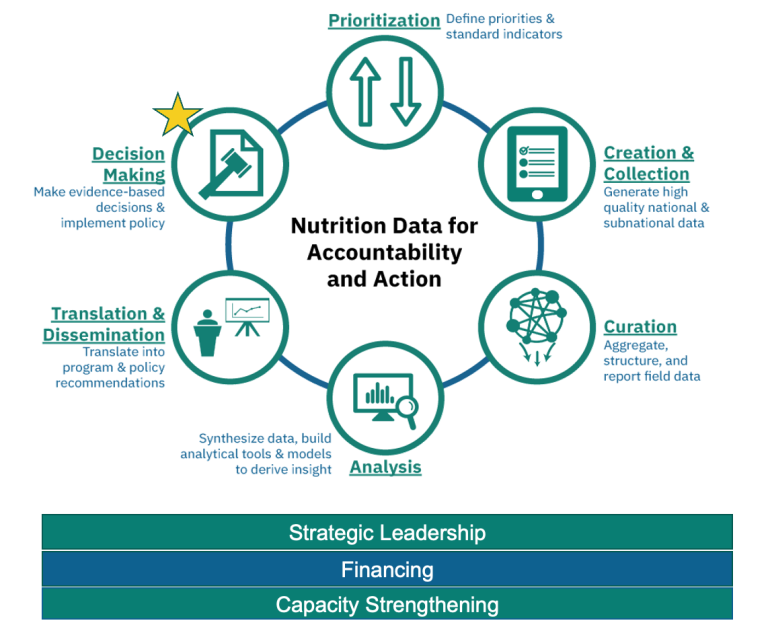
“Finding high-value uses and creating a process to transform raw data into actionable information is the essence of the data value chain. …. Ultimately, when data are put to use, they have an impact: a decision is made, a condition is altered, and someone’s well-being is affected.”
Open Data Watch (March 2018) The Data Value Chain: Moving from Production to Impact
DataDENT was an early adopter of the nutrition data value chain (DVC) described by Ellen Piwoz and co-authors in their 2019 article in Sight & Life Magazine. The framework has gained traction in global nutrition circles over the last several years. It was spotlighted in the 2017 Global Nutrition Report, referenced in 2021 recommendations for Nutrition for Growth data commitments, and featured in a 2022 WHO-UNICEF guidance about Nutrition Information Systems. At country level “Progress and New Opportunities Towards Strengthening the Nutrition Data Value Chain in Nigeria” was the theme of Nigeria’s 2022 National Nutrition Data & Results Conference.
By adapting the more conventional linear value chain into a circle the nutrition DVC positions “putting the data to use” as the chain’s start and end point. This modification reinforces two important ideas: 1) the needs of nutrition decision makers should define our data priorities and influence the subsequent links in the DVC and 2) we must invest in each link of the chain to reach our goal of better data-driven decisions.
DataDENT has worked since 2017 to strengthen different elements of the DVC. Examples include our global and country work on scorecards, dashboards & profiles which focuses on translation & dissemination. Our ongoing engagement with national and subnational as well as global nutrition actors around their decision needs and data use relates to prioritization. The development of new MIYCN counseling indicators and advocacy for uptake in DHS-8 and national surveys straddles prioritization and creation & collection.
While efforts directed at specific links in the DVC are valuable, they do not get us all the way to a robust culture of using data for decision making. As we advance into a second phase of DataDENT (October 2022-September 2025) we have added three cross-cutting elements to our own version of the nutrition DVC (Figure 1). These elements form an enabling environment for DVC strengthening.
- Strategic leadership that facilitates coordination of actors engaged in the nutrition DVC across sectors
- Financial resources that are appropriately budgeted for and invested in the nutrition DVC
- Capacity strengthening to improve overall nutrition data literacy and build targeted skills among key nutrition DVC actors across sectors
These factors reflect the elements of political commitment, coordination and resources are that required for successful multi sector nutrition policies and programs more broadly.
Since 2020, DataDENT has worked to strengthen strategic planning, resource mobilization and coordination for nutrition data in India and Nigeria’s health sector as well as at global level. Moving forward we are expanding our country engagement to Ethiopia and our work on data frameworks to include all sectors represented in national nutrition strategies. We will also expand our work on nutrition data costing and financing and engage with other actors at global and national levels to identify core competencies for nutrition data literacy and resources for capacity strengthening.
Bookmark this blog and follow DataDENT on Twitter and LinkedIn to learn more about these activities and to be notified when new DataDENT resources are released.
